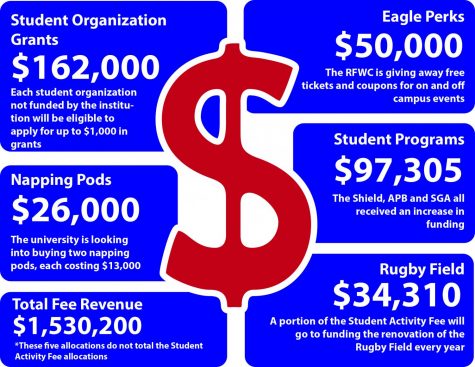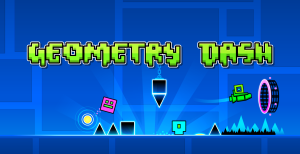Fee increase to fund programs, activities for ‘several years’
October 30, 2017
 Infographic by Abigail Stanley
Infographic by Abigail Stanley
Aleisha Jones said she is quite aware of what she is paying in tuition and fees every semester and she doesn’t want to pay an extra $50 for the student activity fee.
“I am paying for everything out of pocket,” she said.
Jones said she had to get another job over the summer to pay for the estimated tuition and fee increases.
“Just the fees alone went over budget and I was just not anticipating that,” the senior business administration major said. “The student activity fee was increased kind of silently because a lot of the students didn’t know it was being doubled.”
SGA passed a resolution in spring of 2016 recommending the student activity fee be increased from $50 to $100 in an effort to “increase student programming.” The Board of Trustees subsequently passed the recommendation at its meet-
“We are looking at the increase that we did for the current year to be able to fund things for several years,” Associate Vice President for Budget and Planning Mary Hupfer said. “Rather than increasing it a dollar or two, we did it in a larger increment knowing that we wouldn’t be increasing it each year.”
The increase raised $716,910 in additional funding, bringing the total revenue of the Student Activity Fee to $1,584,400.
The Office of Finance and Administration (OFA) asked Associate Provost for Student Affairs Marcia Kiessling to construct a committee of students to determine how the extra fee money would be used.
Kiessling said the purpose of the Student Activity Advisory committee was to brainstorm ideas and make recommendations to the OFA for how the fees should be spent.
Shawneis Jones, a graduate student who served on the committee, said she thought her experience as a new student could help her offer suggestions about how to use the fee to benefit new graduate students.
“One of my biggest tasks was to really get a sense of the university culture and see what things were important to the students and where our strengths and weaknesses lie,” she said.
The results from the committee were separated into two categories: one-time expenses and ongoing expenses.
The top recommendation for the one-time expenses is the revitalization of the Intramural and Recreational Field, also known as the rugby field, while the top recommendation for ongoing expenses was grants for student organizations.
“The committee was formed so that this fee wasn’t just implemented based on what administrators think or what faculty think,” Jones said. “It was really geared toward getting to the bottom of what students need and what can make our experiences better.”
Many of the recommendations from last year are in the process of being implemented, one of which includes adding two napping pods for tired students.
The napping pods, which will cost about $13,000 each with funds from the Student Activity Fee, will be placed in either the Recreation, Wellness and Fitness Center or the Rice Library.
“It would be worth (the student fee money) because it’s a resource that is available to all students,” SGA College of Business Representative Sam Coward said. “It would be different if it wasn’t available to students paying the fee.”
Kiessling said the idea for the pods stemmed from an initiative to better serve commuter students.
“We weren’t really sure if it was just a passing fad or if it was something that people really use, but there is all this interest in it now so we are going to give it a try and see,” she said.
The pods include a privacy visor for seclusion, an interface console to time the duration of the nap and a built-in speaker.
“We talked about what we really want is those commuter students integrated and involved with the entire campus community and not feel segregated,” she said. “Those commuter students drive maybe 30, 45 minutes and they have class and then they have a break and would like to take a nap.”
Kiessling said there was some concern if people may come in and use the pods for extended periods of time.
Other initiatives being implemented include giving every student organization the ability to apply for up to $1,000 in grant money every year, funding Eagle Perks, a program that will give away free tickets and coupons to various activities on and off campus and increasing funding to The Shield, SGA and the Activities Programming Board (APB).
Other funding includes uber services, summer programming, and student art purchasing.
One recommendation that did not get fully funded by the fee was plans to renovate the Intramural and Recreational Field, also known as the rugby field.
Sophomore theatre major Clifton Jett said most of the students on the committee were interested in renovating the rugby field because it would give students a place to hold a wide variety of events.
“The rugby field is a good location on campus where everyone can be a part of the events there,” Jett said. “It’s not just like ‘oh, this is the rugby field, it’s for rugby.’ No, this is the rugby field where you can have a cookout.”
Kiessling said the cost to fully renovate the field would have been all of the funds from the increase. Instead, she said they are going to create a reserve to put money into until it is fully funded.
The total funds for the Student Activity Fee for 2017-2018 fiscal year is $1,530,200, over $50,000 fewer funds than last year.
Hupfer said the largest reason for the decrease was the $57,000 allocated for uncollectible fees.
“Every year, students who aren’t paying their bills,” she said. “When those bills get written off and we can’t collect those, they get expensed back to university. We are seeing that across the entire institution that our level of uncollectible accounts has increased in the last several years.”
Another reason for the decrease is the fall of undergraduate enrollment this year. With fewer students on campus, fewer students are paying the fee which online-only students aren’t required to pay.
Some of the programs overspent and money from the increase was allocated to cover them.
“By moving some of these things out of this funding source into a different funding source, it allowed more focus on the items that are being funded out of there,” Hupfer said.
All but $34,000 of the money raised from the increase was allocated in the 2017-2018 budget.
That money will be used for the napping pods and to fund part of the rugby field renovation.
“I feel like we did a pretty good job of taking the resources and utilizing them in ways that helped a lot of different areas,” Kiessling said. “We added some new innovative programs and services and that was completely a result of creative students who were on this committee.”







